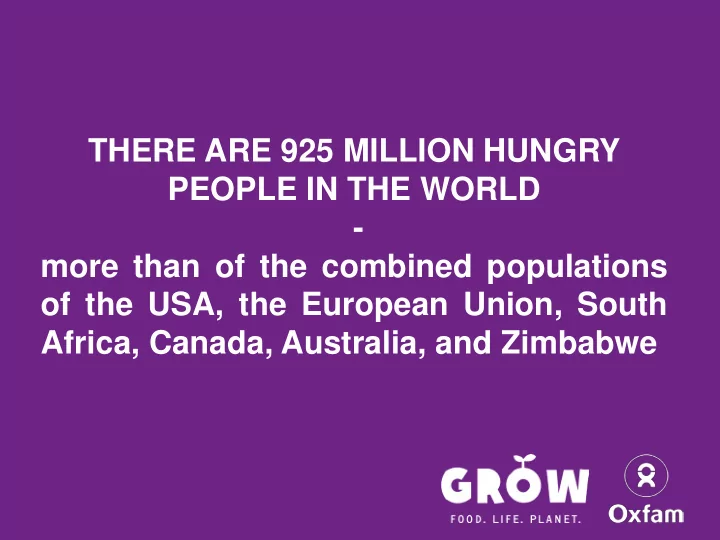

THERE ARE 925 MILLION HUNGRY PEOPLE IN THE WORLD - more than of the combined populations of the USA, the European Union, South Africa, Canada, Australia, and Zimbabwe
HUNGER IS ON THE RISE AGAIN • After decades of grindingly slow progress in the fight to eradicate hunger, it has begun to rise again. Dramatically • Food prices are expected to increase by 70 – 90% by 2030, before taking into account the effects of climate change
SUSTAINABLE INCLUSIVE GROWTH IN ORDER TO FEED 8.2 BILLION PEOPLE IN 2030, WE NEED TO RAISE OVERALL FOOD PRODUCTION BY 50% BETWEEN 2007 AND 2030, WHILE WE DECREASE DRASTICALLY CARBON EMISSIONS
HOW GOVERNMENTS ARE INVESTING: • ODA for agriculture dropped by 77% between 1980 and 2006, but rich countries provide $250bn support to their own farmers, 79 times agricultural aid $bn Worldwide subsidies for renewable energy 57 Worldwide subsidies for fossil fuels 312 (consumption only) Biofuels Subsidies 20 Contributions to the WFP 3.5 Industrialised counties’ agricultural support 252 ODA for Agriculture 9.8
FEED MORE!- BUT YIELDS ARE FLATLINING AND RESOURCES ARE RUNNING OUT • Food demand will increase by 70 per cent by 2050 • We can’t blame resource pressures on growing numbers of poor people, because people living in poverty contribute little to world demand . Skewed power relations and unequal consumption patterns are the real problem • The Green Revolution is over. Yield growth has fallen to just over 1% pa , well below growth in demand. Climate change will make this worse. • Arable land per capita has almost halved since 1960
EXPECTED INCREASE OF FOOD PRICES
WHO ARE AFFECTED THE MOST? 19 37 53 239 578
SMALL SCALE PRODUCERS ACCESS IS ESSENTIAL • To land … • In Guatemala – 8% of the agricultural producer hold 80% of the land • In Brazil – 1% of the population own nearly half of the land • To infrastructure … • Roads and railways to have access to markets • To water for irrigation • To energy for transformation • To technology … • 4 firms control over 50% of the global seed industry sales , 6 firms control over 75% of agrochemicals
SMALLHOLDER AGRICULTURE: THE OPPORTUNITY • 500 million smallholder farms are supporting around 2 billion people, 1/3 of humanity • Hunger, vulnerability, poverty are concentrated in rural areas • It is proved: to invest in smallholder farmers’ productivity and access to markets, increases food availability • So investing to increase access to resources will increase production and close the yield gap
ACTION PLAN OF FOOD PRICES VOLATILITY AND AGRICULTURE G-20 Agriculture Ministers. Paris 22-23 June 2011 “7.- (...) Small scale agricultural producers represent the majority of the food insecure in developing countries and the bulk of production in many countries: increasing their production and income would directly improve access to food among the most vulnerable and improve supply for local and domestic markets” How investment in infrastructure can contribute to this?
ACTION PLAN OF FOOD PRICES VOLATILITY AND AGRICULTURE G-20 Agriculture Ministers. Paris 22-23 June 2011 19 “We encourage (...) to increase investment in developing countries agriculture, and in activities strongly linked to agricultural productivity growth, food security and generation of income in rural areas, such as roads, ports, cold chain, power, irrigation systems (...)” How investment in infrastructure can contribute to this?
SUSTAINABLE AND EQUITABLE GROWTH 1. Promoting sustainable and equitable growth. Poorly distributed growth does not reduce poverty. (average growth rate of 5% often really means 8% growth for the rich and 2% growth for the poor). India and Brazil 2. Equitable investment in rural infrastructure. Provide infrastructure ALSO to small scale producers and not only to large investments and agroindustry 3. Donors and international organisations must continue to raise agriculture spending within overall ODA 4. Rich countries must end their trade-distorting agricultural subsidies once and for all 5. National governments must invest more in agriculture
Recommend
More recommend